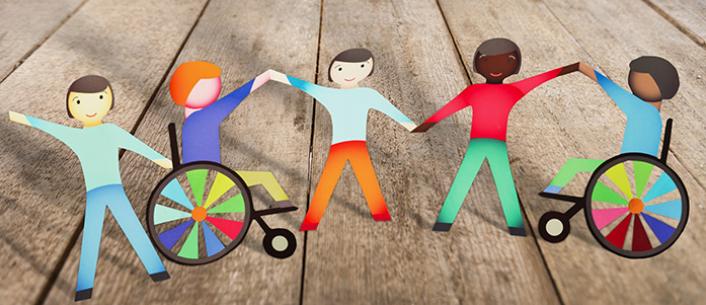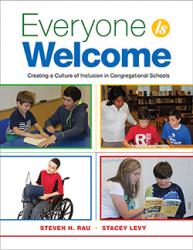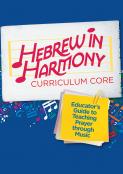- Home
- Play & Learn Home
- Online Enrichment
- Experience Modern Israel
- Israel It's Complicated
- Jewish and Me
- Jewish Holidays Jewish Values
- Jewish Values in Genesis and Jewish Values in Exodus
- Min Ha’aretz
- Our Place in the Universe
- Simply Seder
- The Prophets: Speaking Out for Justice
- Making T'filah Meaningful
- Make, Create, Celebrate
- Yom Haatzmaut Resources
- Hebrew Apps
- About The OLC
- What is the OLC?
- Introduction
- Get Started
- Resources
- OLC Content
- Parent Materials
- See My OLC Classes
- Store
How to Create Inclusive Learning Environments
Written by Behrman House Staff, 31 of January, 2017
February is Jewish Disability Awareness and Inclusion Month, and provides an opportunity to examine how your services and learning environments meet the needs of all your students.
In Everyone is Welcome, Steven Rau and Stacey Levy state that “families need to know that our congregations are safe places for all students, no matter their differences or special needs.” There are ways to adapt school communities, classrooms, and teaching methods to be more accessible and inclusive of all students, regardless of their physical, emotional, or intellectual challenges.
Here are some tips:
Make simple classroom accommodations – Arrange the room so all students can see the board and teacher. If you use pods or groupings around tables, make sure you have a plan for students to face you when speaking. U-shaped setups with the opening facing the board and teacher, whether one large one or several smaller ones, work particularly well for teaching Hebrew.
Limit distractions around the board, have ample workspace for both right- and left-handed children, and consider setting up extra learning space in quiet corners for one-to-one attention.
Click here for examples of specific classroom modifications, from Everyone is Welcome
Teach about diversity – Students of all abilities benefit from lessons about diversity to help them recognize that each of us is unique and that we all have strengths and gifts to offer.
Try this activity, found in the Hebrew in Harmony Curriculum Core: Give each student an orange (lemons work well too). Direct students to study their orange carefully by sight, touch, smell, etc. Collect all the oranges and spread them out on one surface. Direct students to find their own orange and have them explain how they identified which one was theirs. Highlight the unique features they identified, noting that each of us has them too. There is potential for interesting conversation around why it was hard to find one’s own orange.
Another lesson, from Living Jewish Values, focuses on how students can practice k’vod habriyot (individual dignity) in their own lives. One piece of that involves asking students to describe what the world would be like if everyone recognized that we’re made in the image of God.
Foster relationships among learners – Add trust-building and ice-breaker activities to your lessons throughout the yet to build and keep strong connections. One example is Human Bingo, from the forthcoming The Jewish Educator’s Companion, by Batsheva Frankel. Create a sheet to look like a bingo card, with squares listing things like “has been to Israel,” or “plays a sport” or “has more than two pets.” Give each student a sheet. Have them circulate to find people who fulfill each category in a row. Have that person write his or her name or initials next to the category. Afterward, invite volunteers to elaborate on their specific experiences.
Adapt materials –This can be as simple as enlarging print materials for dyslexic students or using more image-reliant materials such as The Gateways Shabbat Family Companion for students with speech and language challenges, as well as non-readers.
For specific learning challenges (from the Hebrew in Harmony Curriculum Core)
Attention issues – Seat learners close to you to minimize distractions, such as noise from a hallway; repeat directions if necessary; privately establish a refocusing system with the student, such as a gentle tap on the shoulder; provide a second copy of materials for the student to keep at home and process in a quieter space; allow the use of “fidgets” (small manipulatives such as stretch or squeeze balls) to help them focus.
Auditory processing issues – Minimize noise and distractions; have students repeat back directions to ensure understanding; consider allowing students to listen to recorded directions and material so they can repeat as frequently as needed. You might create mp3s and load them onto the child’s phone or use a voice recording app on a smartphone or tablet.
Visual processing difficulties – Read written directions and other content aloud; allows students to work with a partner or in small groups, possibly with a madrich or assistant; give students index cards to track line they are reading.
Dyslexia – Enlarge pages on a photocopier; minimize distractions by creating a “word viewer,” which has a word or sentence-shaped hole in the center of card stock; remove time limits and allow students to work at their own pace.
Emotional concerns – Establish the safety of your learning space by building relationships with and between students; provide positive reinforcement regularly to boost self-esteem and encourage participation; allow for shared singing rather than individually; allow for practice or one-on-one time until their confidence grows.
For more information about Jewish Disability Awareness and Inclusion Month, click here for the 2017 Program Guide – a North American-wide resource full of program ideas.





